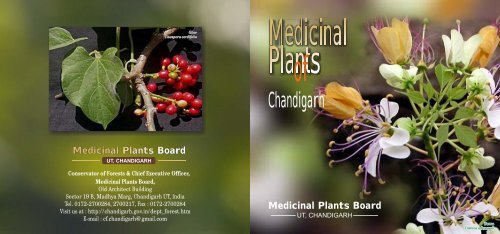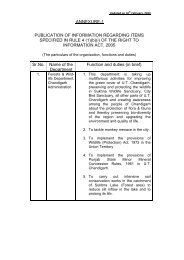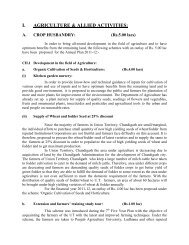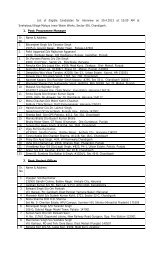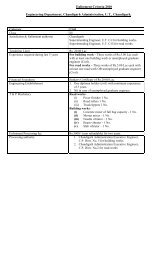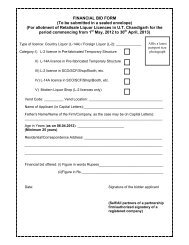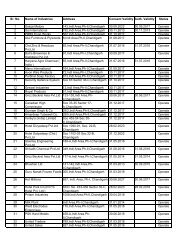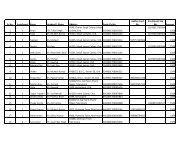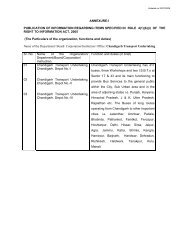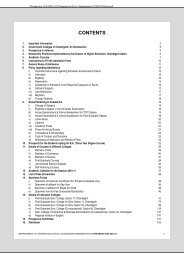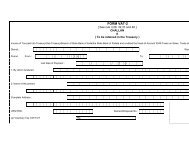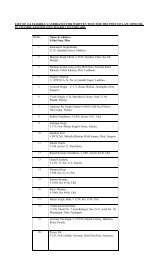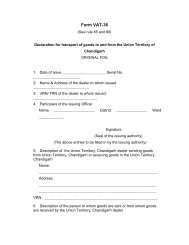Medicinal Plants of Chandigarh
Medicinal Plants of Chandigarh
Medicinal Plants of Chandigarh
Create successful ePaper yourself
Turn your PDF publications into a flip-book with our unique Google optimized e-Paper software.
Giloe<br />
Tinospora cordifolia<br />
<strong>Medicinal</strong><br />
<strong>Plants</strong> <strong>of</strong><br />
<strong>Chandigarh</strong><br />
<strong>Medicinal</strong> <strong>Plants</strong> Board<br />
UT, CHANDIGARH<br />
Conservator <strong>of</strong> Forests & Chief Executive Officer,<br />
<strong>Medicinal</strong> <strong>Plants</strong> Board,<br />
Old Architect Building<br />
Sector 19 B, Madhya Marg, <strong>Chandigarh</strong> UT, India<br />
Tel. 0172-2700284, 2700217, Fax : 0172-2700284<br />
Visit us at : http://chandigarh.gov.in/dept_forest.htm<br />
E-mail : cf.chandigarh@gmail.com<br />
<strong>Medicinal</strong> <strong>Plants</strong> Board<br />
UT, CHANDIGARH<br />
Barna<br />
Crateva adansonii
eface<br />
Sita Ashok<br />
Saraca asoca<br />
State <strong>Medicinal</strong> <strong>Plants</strong> Board, U.T. <strong>Chandigarh</strong> was set up in 2001.<br />
The main objective <strong>of</strong> the Board is to promote In-situ and Ex-situ<br />
Conservation, Research & Development, Education & Awareness amongst<br />
various stakeholders.<br />
A wide variety <strong>of</strong> plants-Trees, Shrubs, Herbs-are having medicinal value. For<br />
wider publicity and knowledge <strong>of</strong> medicinal plants among the masses, Board<br />
is publishing a small booklet, which includes the details <strong>of</strong> <strong>Medicinal</strong> <strong>Plants</strong>,<br />
parts used and its therapeutic value in preventing and curing diseases and<br />
promoting good health.<br />
I am sure, that this booklet will serve as a handy guide for all the<br />
stakeholders, which will help them in easy identification and to understand<br />
usages <strong>of</strong> medicinal plants. This extension activity <strong>of</strong> the board will definitely<br />
sensitize stakeholders and inculcate in them the rich & valuable knowledge<br />
and importance <strong>of</strong> medicinal plants.<br />
Preface<br />
I am highly grateful to Sh. Saurabh Kumar, IFS, DCF (HQ),<br />
Sh. Kuldeep Sharma, IFS, DCF (BG & NR), and Ms. Nitu Rani, Project Fellow,<br />
for their valuable inputs and support for publishing this informative booklet.<br />
Santosh Kumar (IFS)<br />
Chief Executive Officer<br />
<strong>Medicinal</strong> <strong>Plants</strong> Board<br />
U.T. <strong>Chandigarh</strong>
Contents<br />
Index<br />
AAK 1 KALMEGH 22<br />
AKARKARA 2 KIKAR 23<br />
ALOE VERA 3 LAKSHMI TARU 24<br />
AMLA 4 LONG PEPPER 25<br />
ANTAMUL 5 MAIDEN HAIR TREE 26<br />
ARJUNA 6 MANDUKPARNI 27<br />
ASHVAGANDHA 7 MOR PANKHI 28<br />
BAEL 8 NEEM 29<br />
BAHERA 9 NIRGUNDI 30<br />
BANSA 10 PUTH KANDA 31<br />
BARNA 11 RAM TULSI 32<br />
BHRINGRAJ 12 RATI 33<br />
BHUMI AMLA 13 SADA BAHAR 34<br />
BLACK DHATURA 14 SALAR 35<br />
DHAK 15 SATAWAR 36<br />
GILOE 16 SHAM TULSI 37<br />
HARAD 17 SHANKHPUSHPI 38<br />
HENNA 18 SITA ASHOK 39<br />
JAL BHRAMI 19 SOHANJNA 40<br />
JAMUN 20 SWEET FLAG 41<br />
KALA BANSA 21<br />
AAK<br />
Calotropis procera<br />
Habit<br />
Distribution<br />
Parts used<br />
: Erect, much branched shrubs, flower purplish.<br />
: Almost throughout India, Pakistan, W. Aisa, tropical Africa.<br />
: Root, latex, leaf.<br />
Constitutes: α-and β-amyrin,<br />
taraxasterol, taraxasteryl acetate,<br />
giganterol, gigantin, isogiganterol.<br />
Therapeutic uses: The latex and root<br />
bark used as an expectorant; flowers<br />
in cold, cough and asthma.<br />
1
AKARKARA<br />
Spilanthes acmella<br />
ALOE VERA<br />
Aloe barbadensis<br />
Habit<br />
: Annual herb, Flowers white or yellow.<br />
Habit<br />
: Perennial fleshy plant, Flower yellow.<br />
Distribution<br />
Parts used<br />
: Throughout India.<br />
: Leaves, flowers.<br />
Distribution<br />
: It is found in hotter provinces in India. Many <strong>of</strong> the form <strong>of</strong> this<br />
species are naturalized in India and semi-arid regions and dry<br />
westward valleys <strong>of</strong> the Himalaya.<br />
Parts used<br />
: Pulp.<br />
Constitute: Spilanthol.<br />
Therapeutic uses: Leaves are chewed<br />
to relieve toothache and affections <strong>of</strong><br />
throat and gums. Tincture made from<br />
flower heads to treat inflammation <strong>of</strong><br />
Jaw-bones. It increases the flow <strong>of</strong><br />
salvia and is useful in fever especially<br />
during summers.<br />
Constitutes: The pulp contains<br />
glucoside, barbaloin, b-barbaloin and<br />
aloe-emodin.<br />
Therapeutic uses: Used as bitter,<br />
purgative, stomachic, alternative,<br />
a p h r o d i s i a c , a n t h e l m i n t i c ,<br />
emmenagogue, cathartic and blood<br />
purifier. Important constituent <strong>of</strong> skin<br />
care products.<br />
2 3
AMLA<br />
Emblica <strong>of</strong>ficinalis<br />
ANTAMUL<br />
Tylophora indica<br />
Habit<br />
Distribution<br />
Parts used<br />
: Deciduous tree, Flowers minute, greenish.<br />
: Throughout India, Myanmar.<br />
: Fruits, bark, leaf.<br />
Habit<br />
Distribution<br />
Parts used<br />
: A small Evergreen, climbing shrub, flower pinkish yellow.<br />
: Dry forest <strong>of</strong> sub-Himalayan tracts <strong>of</strong> North and East Bengal,<br />
Assam, Cachar, Orissa, Konkan, Deccan, and plains <strong>of</strong> Tamil Nadu.<br />
: Leaf, root.<br />
Constitutes: It is a rich source <strong>of</strong> vitamin C. seeds<br />
contain fixed oil, phospatides and an essential<br />
oil. Fruits and leaves contain tannin,<br />
polyphenolic compounds, corialgin and ellagic<br />
acid.<br />
Therapeutic uses: It is diuretic, laxative, cardiac,<br />
astringent and liver tonic. Useful in anaemia,<br />
diarrhoea and dysentery, dyspepsia,<br />
haemorrhage, inflammation <strong>of</strong> the eyes,<br />
irritability <strong>of</strong> the bladder, jaundice, leucorrhoea<br />
and discharge <strong>of</strong> the blood from the uterus;<br />
affects blackening <strong>of</strong> hair. It is chief ingredient <strong>of</strong><br />
Chyavanprash Avleha, a tonic and restorative in<br />
Indian medicine.<br />
Constitutes:<br />
tylophorine.<br />
Alkaloids containing<br />
Therapeutic uses: It is useful in<br />
bronchitis, cold and cough. Roots<br />
regarded as aboritifacient.<br />
4 5
ARJUNA<br />
Terminalia arjuna<br />
ASHVAGANDHA<br />
Withania somnifera<br />
Habit<br />
: Large tree, Flowers white.<br />
Habit<br />
: Perennial shrub, flowers are greenish or lurid yellow.<br />
Distribution<br />
Parts used<br />
: Sub-Himalayan tracts, North-West India. Sri Lanka.<br />
: Bark.<br />
Distribution<br />
Parts used<br />
: The plant is found in the dried parts <strong>of</strong> India, ascending upto 1700 m<br />
in Himalayas.<br />
: Root, leaf.<br />
Constitutes: Arjunin, a lactonearjunetin,<br />
essential oil and tannin.<br />
Therapeutic uses: It is used as tonic,<br />
a s t r i n g e n t , f e b r i f u g e a n d<br />
deobstruent. Used in for sores. It is<br />
reported as cardiac tonic and useful in<br />
blood dysentery, blood pressure,<br />
fractures <strong>of</strong> bone, heart diseases,<br />
leucorrhoea and earache, and acts as<br />
an antidote to poisons.<br />
Constitutes: Essential oil ipuranol, a<br />
crystalline alcohol, whithaniol,<br />
w i t h a n i n i e , s o m n i f e r e n e ,<br />
hentriacontane, phytosterol.<br />
Therapeutic uses: It is used as<br />
alternative, aphrodisiac, tonic,<br />
deobstruent, diuretic, narcotic,<br />
hypnotic. Sedative, restoration,<br />
abortifacient, useful in rheumatism,<br />
cough, debility from old age, dropsy,<br />
emaciation <strong>of</strong> children and general<br />
weakness.<br />
6 7
BAEL<br />
Aegle marmelos<br />
BAHERA<br />
Terminalia bellerica<br />
Habit<br />
: Moderate-sized tree, Flower greenish-white, sweet-scented.<br />
Habit<br />
: A large, deciduous tree, flowers pale-green.<br />
Distribution<br />
: Throughout India, Myanmar and Sri Lanka.<br />
Distribution<br />
: Throughout the country.<br />
Parts used<br />
: Whole plant.<br />
Parts used<br />
: Fruit.<br />
Constitutes: The fruit contains<br />
marmalosin, bark contains coumarin,<br />
and umbelliferone; Leaves are having<br />
essential oil consisting <strong>of</strong> α and β-<br />
phellandrene.<br />
Therapeutic uses: It is useful in<br />
chronic dysentery, diarrhoea, appetite<br />
and digestion. Locally, the bark<br />
decoction is taken thrice a day for one<br />
week intermittent fever. The root is<br />
one <strong>of</strong> the ingredients <strong>of</strong> the<br />
'Dasamool' <strong>of</strong> Ayurveda.<br />
Constitutes: The fruits contain tannin,<br />
sitosterol, gallic acid, chebulegic acid<br />
etc.<br />
Therapeutic uses: It is bitter,<br />
astringent, anthementic, pungent,<br />
laxative and are used in piles,<br />
enlargement <strong>of</strong> spleen, diarrhoea, eye<br />
troubles, leprosy and headache. One<br />
<strong>of</strong> the component <strong>of</strong> Triphla.<br />
8 9
BANSA<br />
Adhatoda zeylanica<br />
BARNA<br />
Crateva adansonii<br />
Habit<br />
: Shrub, Flowers white, with pink stripes.<br />
Habit<br />
: Tree, flowers greenish – white.<br />
Distribution<br />
: Throughout India.<br />
Distribution<br />
: Throughout India, Pakistan, Myanmar and Sri Lanka.<br />
Parts used<br />
: Flowers, leaves and roots.<br />
Parts used<br />
: Bark, leaf.<br />
Constitutes: Leaves and flowers contain<br />
alkaloids vasicine. Vasicinone, α-sitosterol &<br />
kaemp-ferol.<br />
Theapeutic uses: Leaves and roots are useful in<br />
cough, asthma, bronchitis, rheumatism and as<br />
insecticidal. Flowers, leaves and roots are<br />
antiseptic, antispasmodic, allevative, blood<br />
purifier and tonic. It is common remedy for<br />
cough, lung complaints, anaemia and asthma.<br />
For immediate expectoration in children and<br />
spasmodic attack <strong>of</strong> asthma, fresh juice gives<br />
immediate relief, which may be followed by<br />
other preparations <strong>of</strong> the drug. The twigs <strong>of</strong> the<br />
plant when used as tooth sticks <strong>of</strong>fer a cure for<br />
pyorrhea.<br />
Constitutes: Bark contains tannin and<br />
saponin.<br />
Therapeutic uses: It is used as bitter,<br />
anti-periodic, tonic and demulcent. It<br />
is useful in calculus and affections <strong>of</strong><br />
urinary organs.<br />
10 11
BHRINGRAJ<br />
Eclipta prostrata<br />
BHUMI AMLA<br />
Phyllanthus fraternus<br />
Habit<br />
: Herb with white flowers.<br />
Habit<br />
: Annual herb, Flowers very small, creamy-white.<br />
Distribution<br />
: It is common in moist situations throughout India, ascending<br />
2000 m on the hills.<br />
Distribution<br />
: It occurs sporadic in wastelands in subtropical regions upto 1000 m<br />
elevation.<br />
Parts used<br />
: Whole herb.<br />
Parts used<br />
: Whole herb.<br />
Constitutes: Leaves contain methanol,<br />
stigmasterol, β-amyrin, mixture <strong>of</strong><br />
desmethyl wedelolacetone.<br />
Therapeutic uses: It is used as tonic,<br />
deobstruent in hepatic and spleen<br />
enlargement. The plant juice in<br />
combination with aromatics is<br />
administered for jaundice. Leaves are<br />
useful in scorpion sting. Root is emetic,<br />
applied externally as antiseptic to<br />
ulcers and wounds. The oil prepared<br />
with this herb is <strong>of</strong> great repute as a<br />
hair dye and has cooling affect on the<br />
brain.<br />
Constitutes: Phyllanthusolactone and<br />
Phyllanthodocosanyl ester.<br />
Therapeutic uses: The herb possesses<br />
astringent, stomatic, cholagogue<br />
laxative, deobtruent and bitter tonic<br />
properties. It is used as a remedy for<br />
dropsical disorders, gonorrhea and<br />
other genitourinary disease, jaundice,<br />
constipation, stomachache, dyspepsia<br />
and dysentery. Locally, its juice is used<br />
in case <strong>of</strong> liver disorder.<br />
12 13
BLACK DHATURA<br />
Datura metel<br />
DHAK<br />
Butea monosperma<br />
Habit<br />
Distribution<br />
Parts used<br />
: Herbaceous plant with pale-white flowers.<br />
: It is found as weed on waste places in all over India, occasionally<br />
grown in gardens.<br />
: Whole plant.<br />
Habit<br />
Distribution<br />
Parts used:<br />
: Deciduous tree, flowers-orange-red.<br />
: Throughout India. Sri Lanka and Myanmar, also eastward as far as Papua,<br />
New Guinea and China.<br />
Flower, bark exudation.<br />
Constitutes: The plant contains<br />
scopolamine, hyoscyamine, hyoscine,<br />
atropine and vitamin C.<br />
Therapeutic uses: The herb is<br />
violently narcotic. Seeds, leaves and<br />
roots are considered useful in insanity,<br />
fever with catarrhal and cerebral<br />
complications, diarrhoea, skin<br />
diseases, lice infestation etc.<br />
Constitutes: Butrin, Butein, Butin,<br />
Flavonoidees, Steroides.<br />
Therapeutic uses: Bark astiringent<br />
used piles, tumours and menstrual<br />
disorders. Tree yields a gum called<br />
Butea gum or Bengal kino which is<br />
astringent and used in diarrhoea.<br />
Flowers yield a brilliant but very fugitive<br />
yellow colouring matter. When the<br />
seeds are pounded with lemon juice,<br />
they act as a powerful rubefacient and<br />
have been successfully used as a cure<br />
for a form <strong>of</strong> herpes called Dhobie's<br />
itch.<br />
14 15
GILOE<br />
Tinospora cordifolia<br />
HARAD<br />
Terminalia chebula<br />
Habit<br />
Distribution<br />
Parts used<br />
: A glabrous, climbering, succulent. Flowers small and greenish-yellow.<br />
: The climber is found throughout the tropical regions <strong>of</strong> India.<br />
: Stem.<br />
Habit<br />
Distribution<br />
: A deciduous tree. Flowers dull white.<br />
: Abundant in Northern India from Uttaranchal to Bengal and<br />
southwards to the Deccan, Sri Lanka, Myanmar and Malaya.<br />
Parts used<br />
: Fruits.<br />
Constitutes: Tinosporin and α<br />
furanoid diterpene, giloin, giloinin,<br />
berberine.<br />
Therapeutic uses: it is an alternative,<br />
a n t h a l m i n t i c , a n t i - a r t h r i t i c ,<br />
antiperiodic, anti-pyretic, aphrodisiac,<br />
bitter tonic, blood purifier, cardiac,<br />
carminative, digestive, diuretic and<br />
expectorant.<br />
Constitutes: Tannin, chebulic acid,<br />
chebullic acid, ellagic acid, gallic acid<br />
and resin.<br />
Therapeutic uses: It is useful in<br />
asthma, bile trouble, bleeding and<br />
ulceration <strong>of</strong> the gum, blood pressure,<br />
burns and scalds, carious teeth, colling<br />
wash <strong>of</strong> the eyes, cough, dysentery,<br />
diarrhoea, piles, vaginal discharge,<br />
ulcers, vomiting, and worms.<br />
16 17
HENNA<br />
Lawsonia inermis<br />
JAL BHRAMI<br />
Bacopa monnieri<br />
Habit<br />
: A much branched shrub. Flowers small, fragrant white or pinkish in<br />
colour.<br />
Habit<br />
: Succulent herb, Flowers bluish-purple or white with<br />
bluish veins.<br />
Distribution<br />
: Commercially cultivated cash crop in Rajasthan, Punjab,<br />
Madhya Pradesh, Chhatisgarh and Gujrat.<br />
Distribution<br />
: It is found in marshy tracts in Sub-tropical region, upto 1000m<br />
elevation.<br />
Parts used<br />
: Leaves, bark and seeds.<br />
Parts used<br />
: Whole herb.<br />
Constitutes: Lawsone, esculetin,<br />
fraxetin, isoplumbagin, scopoletin,<br />
betulin, betulinic acid, hennadiol,<br />
lupeol, lacoumarin, quinone and<br />
napthaquinone.<br />
Therapeutic uses: Leaves are<br />
astringent. The decoction <strong>of</strong> leaves is<br />
used as gargle in sore throat. Paste <strong>of</strong><br />
the leaves is applied for relieving<br />
headache and burning sensation in<br />
feet. It also applied on boils, burns and<br />
skin diseases. Leaves are used in the<br />
treatment <strong>of</strong> typhoid and haemorragia.<br />
Constitutes: Saponins, Sterols,<br />
Herpestine, Brahmine, Hersaponin,<br />
monnierin.<br />
Therapeutic uses: Medicine used as a<br />
nerve tonic, diuretic and blood<br />
purifier. It is used as “Memory Plus”.<br />
18 19
JAMUN<br />
Syzygium cumini<br />
KALA BANSA<br />
Barleria prionitis<br />
Habit<br />
: Evergreen tree, flowers greenish-white and fragrant.<br />
Habit<br />
: Shrub with whitish bark, Flowers orange-yellow.<br />
Distribution<br />
: Throughout India.<br />
Distribution<br />
: India, Tropical Africa and Asia, Sri Lanka, South Africa.<br />
Parts used<br />
: Fruit, seed, bark.<br />
Parts used<br />
: Whole herb.<br />
Constitutes: Lauric, myristic, palmitic,<br />
stearic, oleic, linoleic, malvalic,<br />
sterculic, vernolic acid and β-<br />
sitosterol.<br />
Therapeutic uses: Fresh bark juice<br />
mixed with milk is used in diarrhea.<br />
The seed powder about 15 gm is<br />
administered orally thrice a day for 3-4<br />
months in diabetes. The bark is used in<br />
sore throats, bronchitis, asthma,<br />
ulcers and dysentery.<br />
Constitutes: Phenylethanol glycoside,<br />
Barlerinoside, Shanzhiside methyl<br />
ester. Berlerin, Acetylbarlerin,<br />
Lupulinoside.<br />
Therapeutic uses: Juice <strong>of</strong> the leaves<br />
given with honey in catarrhal<br />
affections <strong>of</strong> children. A paste <strong>of</strong> the<br />
roots applied to boils and glandular<br />
swellings. Leaves chewing relieves<br />
tooththache. Roots febrifuge.<br />
20 21
KALMEGH<br />
Andrographis paniculata<br />
KIKAR<br />
Acacia nilotica<br />
Habit<br />
: Annual herb, Flowers small, rose coloured.<br />
Habit<br />
: A moderate-sized tree, Flowers yellow.<br />
Distribution<br />
: It is native to tropical Asia, occurs throughout India.<br />
Distribution<br />
: Indigenous in most hotter parts <strong>of</strong> India, Arabia and Africa.<br />
Parts used<br />
: Whole herb.<br />
Parts used<br />
: Heart wood, Gum, Pod and Bark.<br />
Constitutes: It is known as 'King <strong>of</strong><br />
bitters'. It is the source <strong>of</strong> several<br />
diterpenoids <strong>of</strong> which the bitter water<br />
soluble lactone and rographolide is<br />
important.<br />
Therapeutic uses: It possesses bitter,<br />
tonic, febrifuge, antidysentric,<br />
antiperiodic properties. It is effective<br />
against chronic malaria, jaundice,<br />
anemia, bowel complaints and loss <strong>of</strong><br />
appetite.<br />
Constitutes: Contains several<br />
p o l y p h e n o l s l i k e c a t e c h i n ,<br />
epicatechin, dicatechin, quercertin<br />
and tannin.<br />
Therapeutic uses: Various plant parts<br />
are used against hairfall, earache,<br />
syphilis, cholera, dysentery, leprosy<br />
and rinderpest.<br />
22 23
LAKSHMI TARU<br />
Simarouba glauca<br />
LONG PEPPER<br />
Piper longum<br />
Habit<br />
: Tree, Flowers greenish – yellow.<br />
Habit<br />
: A creeping aromatic herb.<br />
Distribution<br />
Parts used<br />
: Tropical America, Kenya and Central Africa. Introduced in India.<br />
: Leaves, seeds.<br />
Distribution<br />
Parts used<br />
: It grows in tropical zones and distributed in Central Himalaya, Khasi<br />
and Mikir hills, Western Ghats, lower hills <strong>of</strong> W. Bengal and Assam.<br />
: Fruit.<br />
Constitutes: Ailanthinone, melianone,<br />
benzoquinone, canthin, glaucarubine,<br />
glaucarubolone, glaucarubinone,<br />
h o l a c a n t h o n e , s i m a r o u b i d i n ,<br />
simarolide, simarubolide, sitosterol, and<br />
tirucalla.<br />
Therapeutic uses: An infusion <strong>of</strong> the<br />
leaves or bark is considered to be<br />
astringent, a digestion and menstrual<br />
stimulant and an antiparasitic remedy. It<br />
is taken internally for diarrhoea,<br />
dysentery, malaria, and colitis; it is used<br />
externally for wounds and sores.<br />
Constitutes: The fruits contains<br />
piperine and piplartine alkaloid.<br />
Therapeutic uses: The root is used as a<br />
carminative, tonic to the liver,<br />
s t o m a c h i c , e m m e n a g o g u e ,<br />
abortifacient and aphrodisiac. It is<br />
effective to treat insomnia, epilepsy,<br />
obstruction <strong>of</strong> bile duct and gall<br />
bladder, dysentery and leprosy. The<br />
fruits possess haematinic, diuretic,<br />
digestive, tonic properties and useful in<br />
inflammation <strong>of</strong> the liver, pains in the<br />
joints, snakebite, scorpion sting and<br />
night blindness.<br />
24 25
MAIDEN HAIR TREE<br />
Ginkgo biloba<br />
MANDUKPARNI<br />
Centella asiatica<br />
Habit<br />
: Deciduous tree.<br />
Habit<br />
: The herb trails on ground, flowers minute, pinkish and red.<br />
Distribution<br />
: Native <strong>of</strong> China.<br />
Distribution<br />
: It grows in moist places throughout India.<br />
Parts used<br />
: Leaves.<br />
Parts used<br />
: Whole plant.<br />
Constitutes: Leaves contain shikimic<br />
acid, flavonoids and also constitute<br />
phenolic components, sesquitepene,<br />
b i l o b a l i d e<br />
a n d<br />
β-sterol. Seeds contain alkaloids<br />
ginkgotoxin and amino-acid.<br />
Therapeutic uses: Nuts are used<br />
against cancer in China. Leaves are used<br />
in cardiovascular disorders, increased<br />
cerebral blood circulation and<br />
parkinson's diseases. The seed is used<br />
as an anti-tusive and expectorant in<br />
Japan and China. It is a Central Nervous<br />
System (CNS) improver, best brain<br />
tonic, memory sharpener in old ages.<br />
Constitutes: The herb contains bitter<br />
substance, anglucoside-asiaticoside,<br />
essential and fatty oil, sitosterol. Tannin<br />
and resinous substance besides an<br />
alkaloid hydrocotylin. A bitter principle<br />
vallarine, pectin acid and resin are<br />
present in the leaves and roots <strong>of</strong> the<br />
plants.<br />
Therapeutic uses: The leaves or entire<br />
herb is boiled in water and this decoction<br />
is given in the treatment <strong>of</strong> leprosy and<br />
useful in epilepsy and is a tonic for brain.<br />
It is also reputed to improve the power <strong>of</strong><br />
speech and poetic imagination. It is useful<br />
remedy for mentally retarded children.<br />
26 27
MOR PANKHI<br />
Thuja orientalis<br />
NEEM<br />
Azadirachta indica<br />
Habit<br />
: An evergreen tree.<br />
Habit<br />
: Large tree, Flowers white.<br />
Distribution<br />
: China, widely cultivated in North Indian gardens.<br />
Distribution<br />
: Native <strong>of</strong> Myanmar, Cultivated throughout hotter part <strong>of</strong> India.<br />
Parts used<br />
: Fruit, leaf.<br />
Parts used<br />
: The whole plant.<br />
Constitutes: Thujone, isothujone,<br />
fenchone, sabines and α-pinen as the<br />
m a i n m o n o t e r p e n e s . O t h e r<br />
m o n o t e r p e n e s , n a m e l y<br />
carvotanacetone, origanol, origanes,<br />
myrcen and camphen.<br />
Therapeutic uses: Anti-inflammatory,<br />
e x p e c t o r a n t , a n t i a s t h m a t i c ,<br />
antibacterial, antifungal, haemostatic<br />
activities. Seeds lever tonic, weakness<br />
<strong>of</strong> body.<br />
Constitutes: Leaves contain the<br />
flavanoid quercetin, nimbosterol<br />
kaempferol and myricetin. Seed and<br />
oil contains desacetylnimbin,<br />
azadirachtin, nimbidol, meliantriol,<br />
tannic acid and amino acids.<br />
Therapeutic uses: Used in leprosy,<br />
intestinal worms, piles and urinary<br />
diseases. Root bark and young fruits<br />
are astringent, tonic and antiperiodic.<br />
Bark is bitter, tonic, astringent and<br />
vermifuge. Fruit is purgative,<br />
emollient and anthelmintic. Leaves<br />
are discutient, insect repellent, leaf<br />
28<br />
juice anthelmintic.<br />
29
NIRGUNDI<br />
Vitex negundo<br />
PUTH KANDA<br />
Achyranthes aspera<br />
Habit<br />
: A shrub or small tree with blue flowers.<br />
Habit<br />
: A Herb, Flowers green or pinkish.<br />
Distribution<br />
Parts used<br />
: Throughout India. Sri Lanka.<br />
: Whole plant.<br />
Distribution<br />
Parts used<br />
: It is found throughout India upto 1300 m. As a weed, it is found in<br />
perennial crops, grasslands, waste places, shaded or unshaded areas.<br />
: Whole plant.<br />
Constitutes:<br />
glycosides.<br />
Essential oil, sflavone<br />
Constitutes: Seed contains two saponins;<br />
saponin α and saponin β.<br />
Therapeutic uses: The leaves possess<br />
alternative, anodyne, antiarthritic,<br />
antiparasitic, appetizer, aromatic,<br />
astringent, discutient, febrifge and<br />
nerine tonic properties. It is also<br />
useful in asthma, lung diseases, spenic<br />
enlargement, urinary troubles,<br />
tonsillitis, sciatica rheumatism etc.<br />
Therapeutic uses: The herb possesses<br />
antidiabitic and antirheumatic properties.<br />
Seeds are used as inflammatory,<br />
acrdiotonic and diuretic and used to treat<br />
snake bites, hydrophobia and itchings. Its<br />
powder is used in the treatment <strong>of</strong> bleeding<br />
piles. Locally, the decoction <strong>of</strong> the herb is<br />
diuretic and used in renal dropsy and<br />
generalized anasarca. Leaf juice is useful in<br />
stomachache, bowel complaints, piles and<br />
abscess. The extract <strong>of</strong> the root is used to<br />
treat menstrual disorders and dysentery.<br />
30 31
RAM TULSI<br />
Ocimum sanctum<br />
RATI<br />
Abrus precatorius<br />
Habit<br />
Distribution<br />
Parts used<br />
: A much-branched, aromatic and erect herb with purplish or crimson<br />
flowers.<br />
: Throughout India, ascending upto 1800 m in the Himalayas.<br />
: Leaves, seeds.<br />
Habit<br />
Distribution<br />
Parts used<br />
: Woody climber, Flowers pale-violet at first, reddish afterwards.<br />
: Sub-Himalayan tracts.<br />
: Seeds and Roots.<br />
Constitutes: Leaves and seeds yield an<br />
essential oil containing eugenol,<br />
carvacrol, methyl eugenol and<br />
caryophyllence.<br />
Therapeutic uses: The oil possesses<br />
antibacterial and insecticidal properties.<br />
Seeds are mucilaginous, demulcent,<br />
useful in complaints <strong>of</strong> the urinary<br />
systems. The juice or infusion <strong>of</strong> leaves<br />
possesses diaphoretic, antiperiodic,<br />
simulating and expectorant properties.<br />
It is used in bronchitis, applied to skin in<br />
ringworm and other cutaneous diseases<br />
and dropped into the ear to relieve<br />
earache.<br />
Constitutes: Seeds contain abrin,<br />
abrine and abarnin while roots contain<br />
precol, abrol and two alkaloids<br />
abraime & orecasine.<br />
Therapeutic uses: Seeds are<br />
purgative, emetic, tonic, aphrodisiac<br />
in nature. Roots are emetic, alexiteric.<br />
Locally, the leaf juice mixed with oil is<br />
applied on painful swellings <strong>of</strong> the<br />
body. The root used as a substitude <strong>of</strong><br />
liquorice.<br />
32 33
SADA BAHAR<br />
Catharanthus roseus<br />
SALAR<br />
Boswellia serrata<br />
Habit<br />
: Perennial Herb or undershrub, flowers white, pink or purplish<br />
Habit<br />
: Deciduous trees, flowers small, white.<br />
Distribution<br />
: Native <strong>of</strong> Madagascar, cultivated in most <strong>of</strong> the tropical countries.<br />
Distribution<br />
: Western Himalaya, outer hills, Central and South India, tropical Africa.<br />
Parts used<br />
: Leaves and Roots.<br />
Parts used<br />
: Resinous exudation <strong>of</strong> bark.<br />
Constitutes: The alkaloids like Vincristine<br />
sulphate are being marketed under the<br />
trade name ONCOVIN which is used against<br />
acuteleukemia, and vinblastine sulphate as<br />
VELBE to cure Hodgkin's disease and other,<br />
lymphomasand Choriocarnciomas.<br />
Therapeutic uses: The root bark contains<br />
the alkaloid Alstonine which has been used<br />
traditionally for its calming effect and its<br />
ability to reduce blood pressure. The anti<br />
cancer drug namely Vincristine and<br />
Vinblastine are produced from Sadabahar<br />
which is helpful in the treatment <strong>of</strong><br />
Leukemia in children and lymphoma. Most<br />
commonly used in treatment <strong>of</strong><br />
Lymphomas, Hodgkin's disease, Breast<br />
cancer, Acute Lymphocytic Leukemia.<br />
Constituents: Boswellic acid<br />
Therapeutic uses: The bark is sweet, acrid,<br />
cooling and tonic. It is good for vitiated<br />
conditions <strong>of</strong> pitta, asthma, dysentery, ulcers,<br />
haemorrhoids and skin diseases. The gumresin<br />
is sweet, bitter, astringent, antipyretic,<br />
antidysenteric, expectorant, diaphoretic,<br />
diuretic, stomachic and emmenagogue. It is<br />
useful in fevers, diaphoresis, convulsions,<br />
urethorrhea, orchiopathy, bronchitis, cough,<br />
stomatitis, jaundice and arthritis.<br />
34 35
SATAWAR<br />
Asparagus racemosus<br />
SHAM TULSI<br />
Ocimum tenuiflorum<br />
Habit<br />
Distribution<br />
Parts used<br />
: Straggling or scandent, much branched perennial Shrub, Flowers<br />
white.<br />
: Throughout India.<br />
: Roots and flowers.<br />
Habit<br />
Distribution<br />
Parts used<br />
: Aromatic herb, 30-90 cm high. Flowers purplish-pink.<br />
: Throughout India, Sri Lanka, W. Asia, Australia.<br />
: Leaves, seeds.<br />
Constitutes: Tuberous roots contains<br />
four saponins, viz. Shatavarin I to IV.<br />
S h a t a v a r i n i s g l y c o s i d e o f<br />
sarsasapogenin. Flower caontains<br />
quercetin, rutin & hyperoside.<br />
Therapeutic uses: It has also been<br />
identified as one drug to control the<br />
symptoms <strong>of</strong> AIDS. It is said to be tonic<br />
and diuretic and used as galactogogue<br />
& aphrodisiac. Dried tuberous roots<br />
has ulcer healing resistance or<br />
cytoprotection.<br />
Constitutes: Alkaloids, Glycosides,<br />
Saponins, Tannins, Ascorbic acid and<br />
Carotene.<br />
Therapeutic uses: It is regarded as a<br />
sacred plant, worshipped and used in<br />
several religious ceremonies; plant<br />
highly medicinal for fever, cold and<br />
cough; colitis, urinary troubles and<br />
vomiting; believed to be instant<br />
remedy <strong>of</strong> all types <strong>of</strong> disorders; <strong>of</strong>ten<br />
conserved.<br />
36 37
SHANKHPUSHPI<br />
Evolvulus alsinoides<br />
SITA ASHOK<br />
Saraca asoca<br />
Habit<br />
: Perennial herb with pale-blue to purplish flowers.<br />
Habit<br />
: Small tree, Flowers in dense clusters yellow, turning red with age.<br />
Distribution<br />
: Throughout India, tropical and subtropical regions <strong>of</strong> the globe.<br />
Distribution<br />
: Central, Eastern and South India. Sri Lanka.<br />
Parts used<br />
: Whole plant.<br />
Parts used<br />
: Flower, seeds and dried bark.<br />
C o n s t i t u t e s : A n a l k a l o i d -<br />
shankhapushpine. Fresh plant contains<br />
volatile oil and potassium chloride.<br />
Therapeutic uses: Tonic and febrifuge,<br />
also used as vermifuge and, with oil, for<br />
promoting growth <strong>of</strong> the ha<br />
Constitutes: Flowers give β-sitosterol,<br />
flavonoids and flavones glycosidesquercetin,kaempferol,quercetin,<br />
glucoside.The anthocyanins present<br />
are pelargonidin and cyanadin-3, 5-<br />
diglucoside. Bark yields catechol and<br />
sterols.<br />
Therapeutic uses: Powdered flowers<br />
mixed with water is given for<br />
haemorrhagic dynsentery. Seeds are<br />
used to cure urinary discharge. Dried<br />
bark is astringent and used to treat<br />
excessive menstruations as a uterine<br />
sedative.<br />
38 39
SOHANJNA<br />
Moringa oleifera<br />
SWEET FLAG<br />
Acorus calamus<br />
Habit<br />
: Medium-sized deciduous tree. Flowers pinkish-white.<br />
Habit<br />
: Semi-aquatic or marshy, perennial herb.<br />
Distribution<br />
: Throughout the India.<br />
Distribution<br />
: It is found Throughout India and Pakistan in damp marshy<br />
Parts used<br />
: Leaf, fruit, flowers.<br />
Parts used<br />
open places, prefer waterlogged conditions.<br />
: Dried Rhizomes.<br />
Constitutes: Acrid and pungent<br />
alkaloid, palmitic, stearic, myristic,<br />
oleic, and behenic acids, phytosterin.<br />
bassorin, moringo-tannic acid.<br />
Therapeutic uses: Anti-inflammtory<br />
and Antitumor Activities, Ovarian<br />
Cancer, Asthma, Antibiotic, Hormonal<br />
properties, Abortifacient.<br />
Constitutes: contain a yellow bitter<br />
aromatic volatile oil. It contains α-<br />
pinene, d-camphene, calamene,<br />
calamenol, calamenone and alcohols.<br />
The roots also contain a glucoside,<br />
'Acorin', calamene, tannin, mucilage,<br />
starch and vitamin C.<br />
Therapeutic uses: Powered roots are<br />
used as vermifuge, emetic, stomachic<br />
and carminative. Locally, its paste is<br />
applied directly on the forehead during<br />
fever. Sometimes, in Kwashiorkor<br />
disease <strong>of</strong> children, small pieces <strong>of</strong> roots<br />
are tied around the neck<br />
40 41
Activities <strong>of</strong> <strong>Medicinal</strong> <strong>Plants</strong> Board<br />
Union Territory, <strong>Chandigarh</strong><br />
<strong>Medicinal</strong> <strong>Plants</strong> Nursery - Botanical Garden<br />
Sarangpur, (UT) <strong>Chandigarh</strong><br />
The <strong>Medicinal</strong> <strong>Plants</strong> Board (MPB), Union Territory, application to the CEO (MPB). Board in<br />
<strong>Chandigarh</strong> was set up in 2001-02 in the Collaboration with schools and colleges has<br />
Department <strong>of</strong> Forests, <strong>Chandigarh</strong> Administration. established Harbal Gardens in 41 schools and 5<br />
The Board is responsible for coordination <strong>of</strong> all colleges <strong>of</strong> <strong>Chandigarh</strong> and 1 in Punjab University, to<br />
matters related to medicinal plans which include create awareness among students and teachers<br />
promotion <strong>of</strong> in-situ conservation, ex-situ about our rich medicinal plants heritage. Board has<br />
cultivation, research and development, education also distributed awareness material in the form <strong>of</strong><br />
and awareness etc. for overall development <strong>of</strong> this tin plates, pamphlets and booklets consisting<br />
sector. With financial assistance from National information on medicinal plants. The students are<br />
<strong>Medicinal</strong> <strong>Plants</strong> Board, the Board has created a visiting the garden on regular basis to acquaint<br />
Harbal Garden over 35 acres <strong>of</strong> land and a Nucleus themselves with various types <strong>of</strong> medicinal plants<br />
Centre near Sarangpur. This Harbal Garden is a part available here. <strong>Medicinal</strong> <strong>Plants</strong> Board's Nucleus<br />
<strong>of</strong> Botanical Garden, <strong>Chandigarh</strong>. It has more than Centre located in the harbal Garden has a library, a<br />
70 species <strong>of</strong> medicinal tress and 65 species <strong>of</strong> Conference Hall and Nature Interpretation Centre.<br />
medicinal herbs. A Nursery has also been Training on medicinal plants is being imparted here<br />
established in this garden. The saplings <strong>of</strong> medicinal to all sections <strong>of</strong> the society.<br />
plants are distributed free <strong>of</strong> cost to the Residents,<br />
For Further details one may contact the Chief<br />
Educational Institutions, Government and Non-<br />
Executive Officer, <strong>Medicinal</strong> <strong>Plants</strong> Board, Union<br />
Government Organizations and Farmers <strong>of</strong> UT<br />
Territory, <strong>Chandigarh</strong>.<br />
<strong>Chandigarh</strong>. To receive <strong>Plants</strong> one has to submit an


